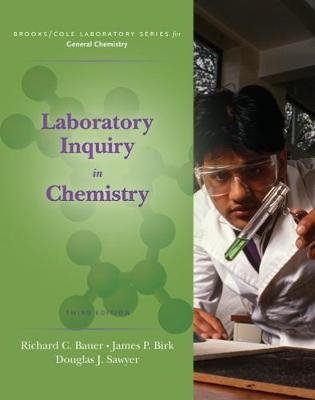
Laboratory Inquiry in Chemistry
Brooks/Cole (Verlag)
978-0-495-11345-4 (ISBN)
- Titel ist leider vergriffen;
keine Neuauflage - Artikel merken
LABORATORY INQUIRY IN CHEMISTRY teaches you the skills you need to easily complete your laboratory investigations. Each investigation begins with a scenario that puts a real-life spin on the problem at hand, provides you with a sense of why the project is relevant, and creates a scenario that is comparable to what chemists face in the real world. Completing experiments is easy with a list of goals, materials, reagents, guidelines, and hints found at the beginning of each investigation.
Richard Bauer received his undergraduate degree from Saginaw Valley State University and his doctorate from Purdue University. He now coordinates the general chemistry program at Arizona State University. His scholarly interests in chemical education include laboratory instruction, TA training, and alternative modes of lecture instruction. James Birk received his undergraduate degree from St. John's University and his doctorate from Iowa State University. His specializations are inorganic chemistry, chemical education, and computer education. He has been a professor for thirty-five years and is tenured at Arizona State University. Birk is the author of several papers appearing in the Journal of Chemical Education" as well as twenty-seven books and monographs." Doug Sawyer received his undergraduate degree from Coe College and his doctorate from Iowa State University. He now teaches at Scottsdale Community College, where he is the chair of the Physical Sciences department. He serves as the American Chemical Society councilor for Central Arizona and is also a chemical consultant for several companies. His work also includes photography for chemistry texts at Houghton Mifflin. In his spare time, he plays bass for the Lynwood Flyers, a local blues band.
The Investigations.
1. What Are the Safety Concerns in the Laboratory?
2. Whats in the Flask?
3. How Should Data Trends Be Presented?
4. How Is Lab Equipment Used?
5. What Relationships Exist Among Elements?
6. What's in the Bottles?
7. How Can the Waste Be Made Useful?
8. Is the Water Hard or Soft?
9. How Hot Is the Water?
10. Which Metal Will Burn the Skin?
11. How Much Acetic Acid Is in Vinegar?
12. Are All Neutralization Reactions the Same?
13. How Many Waters of Hydration Are in the Formula?
14. How Much Sodium Bicarbonate Is in the Mixture?
15. Is It Economical to Recycle Aluminum?
16. What Is a Copper Cycle?
17. Who Wrote the Ransom Note?
18. How Can UV Sensitive Beads Be Used to Test Sunscreens?
19. What Factors Affect the Intensity of Color?
20. How Much Cobalt Is in the Soil?
21. How Much Copper Is in the Coin?
22. Which Iron Compound Is It?
23. Should We Mine This Ore?
24. Why Do Liquids Evaporate at Different Rates?
25. What Are the Structures of Some Alloys?
26. How Is LED Light Color Related to Composition?
27. What Is the Molar Mass of Mars Ice Gas?
28. How Much Gas Is Produced?
29. Which Alcohols Are in the Barrels?
30. How Is Heat of Combustion Measured Indirectly?
31. What Is the Rate Law?
32. How Fast Does the Crystal Violet Decolorize?
33. Why Is the Vinegar Factory Rusting?
34. What Factors Affect the Solubility of Kidney Stones?
35. How Many Chemicals Are in the Vial?
36. What Factors Affect Chemical Equilibrium?
37. What Is the Formation Constant?
38. Are Household Items Acidic, Basic, or Neutral?
39. What Is the pH of Soil?
40. What Is the Acid Dissociation Constant?
41. What Is the Solubility Product?
42. What Are Some Chemical Properties of Cream of Tartar?
43. What Are the Metals?
44. How Can a Battery Be Made from Coins?
45. What Is the Complex Ion?
46. What Formulation Makes the Best Toy?
47. How Are Anions Identified?
48. How Are Cations Identified?
49. How Are More Cations Identified?
50. How Are Ionic Solids Identified?
Appendix A: Automated Data Collection.
Appendix B: Transmittance and Absorbance Data Collection.
Appendix C: Measuring pH.
Appendix D: Temperature Data Collection.
Appendix E: Pressure Data Collection.
Appendix F: Voltage Data Collection.
Appendix G: Selected Laboratory Techniques.
Appendix H: Laboratory Equipment.
Appendix I: Sample Material Safety Data Sheet.
Appendix J: Tables
| Verlagsort | CA |
|---|---|
| Sprache | englisch |
| Maße | 217 x 276 mm |
| Gewicht | 666 g |
| Themenwelt | Naturwissenschaften ► Chemie ► Allgemeines / Lexika |
| Schlagworte | Chemie • Laborchemikalien |
| ISBN-10 | 0-495-11345-X / 049511345X |
| ISBN-13 | 978-0-495-11345-4 / 9780495113454 |
| Zustand | Neuware |
| Haben Sie eine Frage zum Produkt? |
aus dem Bereich


